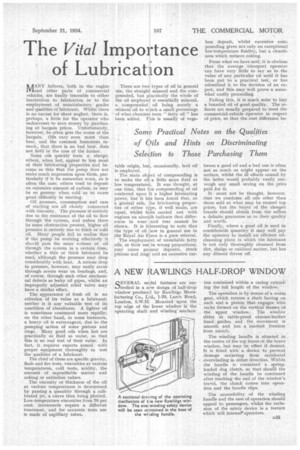The Vital Impoi
Page 93

If you've noticed an error in this article please click here to report it so we can fix it.
of Lubricat:
ft/IANY failures, both in the engine lifianct other parts of commercial vehicles, are finally traceable to either inattention to lubrication or to the employment of unsatisfactory grades
and qualities of lubricant. Whilst there is no excuse for sheei neglect, there is, perhaps, a little for the operator who endeavours. to save, money by purchas
ing at bargain prices. Unfortunately, however, he. often gets the worse of the
bargain. Oils vary even more than beer, and the common. humorous remark,, that there is no bad beer, does not hold in the case of the former,
Some oils quickly form a sludge;
others, when .hot, appear to lose most of their lubricating properties. and be
come so thin that the pump does not make much impression upon them, particularly if it be somewhat worn, as is often the case; others tend to deposit an excessive amount of carbon, or may be so gntruny when cold as to cause great difficulty in starting.
Oil pressure, consumption and ease of starling are all closely connected with viscosity. The pressure is entirely due to the resistance of the oil to flow through the system, and unless there be some obstruction present, higher oil Pressure is entirely due to thick or cold oil. Many people fail to realize that if the pump be working effectively it shcold pass the same volume of oil through the system in a certain •time, whether a thin or thick lubricant he used, although the pressure may drop considerably with heat. A serious drop in pressure, however, may easily occur through severe wear on bearings, and, of course, through such other mechanical defects as leaky oil pipes, whilst an improperly adjusted relief valve may have a similar effect.
The appearance of fresh oil is no criterion of its value as a lubricant; neither is it any valuable test of its condition of cleanliness. A lighter oil is sometimes consumed more rapidly; on the other hand, in some instances, a heavy oil is extravagant, due to the pumping action of some • pistons and rings. Many good oils when hot are practically as fluid as water, so that this is no real test of their value. In fact, it requires experts armed with proper equipment thoroughly to test the qualities of a lubricant.
The chief of these are specific gravity, flash and fire tests, viscosities at various temperatures, cold tests, acidity, the amount of saponifiable matter and coking or oxidation values.
The viscosity or thickness of the oil at various temperatures is determined by passing a quantity through a calibrated jet, a curve then being plotted. Low-temperature viscosities from 70 per cent, downwards require a different treatment, and for accurate tests use is made of capilliary tubes. There are two use, the straighl pounded, but p the oil employer a compounded mineral oil to w. of what chemisb been added. T types of oil in general mineral and the cornactically the whole of is essentiallymineral, oil being merely a Lich a small percentage tenm " fatty oil " has Lis is usually of vege table origin, bui:, occasionally, lard oil is employed.
The main object of compounding is to make the oil' a little more fluid at low temperature. It was thought, at one time, that tine compounding of oil conferred upon it a higher lubricating power, but it has been found that, as a general rule, he lubricating properties of either type, if well made, are equal, whilst tests carried out with engines on aircraft indicate that differences in wear and tear cannot be shown. It is interesting to note that the type of oil :low in general use in the Royal Air Fiuce is a pure mineral.
The employment of unsuitable fatty oils, or their use in wrong proportions, may cause gu:nmy deposits, stuck pistons and ring: and an excessive car-, bon deposit, whilst excessive compounding gives not only an exceptional low-temperature fluidity, but a cleanliness which reduces coking.
From what we have said, it is obvious that • the average transport operator can have very little to say as to the value of any particular oil until it has been put to a practical test, or has submitted it to the decision of an expert, and this may well prove a somewhat costly proceeding.
Failing this, it is much safer to buy a branded oil of good quality. The refiners are usually prepared to meet the commercial-vehicle operator in respect of price, so that the cost difference be
tween a good oil and a bad one is often not so much as might appear on' the surface, whilst the ill effects caused by the latter would probably vastly outweigh any small saving on the price paid for it.
It must not be thought, however. that we condemn all oils other than those sold at what may be termed top prices, but the buyer of the cheaper brands should obtain from the sellers a definite guarantee as to their quality and worth.
Finally, where a goo.d oil is used in considerable quantity it may well pay the operator to install an efficient oilcleansing plant in which the lubricant is not only thoroughly cleansed from dirt, sludge or oxidized matter, but has any diluent driven off.








































































































































































